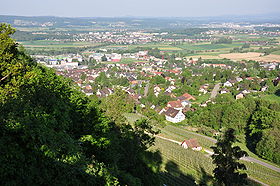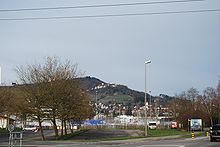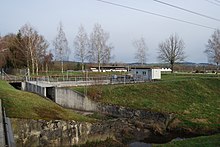Dielsdorf ZH
| ZH is the abbreviation for the canton of Zurich in Switzerland and is used to avoid confusion with other entries of the name Dielsdorf . |
| Dielsdorf | |
|---|---|
| State : |
|
| Canton : |
|
| District : | Dielsdorf |
| BFS no. : | 0086 |
| Postal code : | 8157 |
| UN / LOCODE : | CH DLD |
| Coordinates : | 676.54 thousand / 259731 |
| Height : | 455 m above sea level M. |
| Height range : | 410–654 m above sea level M. |
| Area : | 5.87 km² |
| Residents: | 6001 (December 31, 2018) |
| Population density : | 1022 inhabitants per km² |
|
Proportion of foreigners : (residents without citizenship ) |
31.3% (December 31, 2018) |
| Mayor : | Andreas Denz ( independent ) |
| Website: | www.dielsdorf.ch |
|
View from Regensberg to Dielsdorf |
|
| Location of the municipality | |
Dielsdorf is a political municipality and the capital of the district of the same name in the canton of Zurich in Switzerland .
coat of arms
- In silver on a green three-mountain, an upright black, red-tongued bear, shouldering a de-limbed golden tree trunk
geography
Dielsdorf is located in the northwest of the canton of Zurich. The municipality is located at the eastern end of the Lägern , the easternmost of all Swiss Jura foothills, at the foot of the town of Regensberg .
The municipality has an area of 586 hectares (which is rather small compared to other municipalities), of which 206 hectares are used for agriculture, 158 hectares are forest, 122 hectares are inhabited, 50 hectares are industrial land and the remaining 50 hectares as relaxation zones. The lowest point of the community is the foothills of the Neeracher Ried at 410 m above sea level. M. , the highest point at 653 m above sea level. M. , about at the height of Regensberg.
The municipality of Dielsdorf borders Steinmaur in the north, Niederhasli in the east, Buchs ZH in the south , and the historic town of Regensberg in the west .
population
| Population development | |
|---|---|
| year | Residents |
| 1467 | 290 |
| 1771 | 466 |
| 1836 | 642 |
| 1850 | 674 |
| 1900 | 734 |
| 1950 | 1133 |
| 1960 | 1556 |
| 1975 | 3304 |
| 1990 | 4350 |
| 2008 | 5413 |
On December 31, 2001, 4679 people were registered as residents in the community of Dielsdorf, 50% of them women and men. Of all the inhabitants, 3587 were Swiss citizens.
The community of Dielsdorf offers jobs for around 2000 workers from the near and far area, especially since some large companies have chosen Dielsdorf as the location of their headquarters.
In 2010, 34.6% belonged to the Evangelical Reformed denomination , 27.9% to the Roman Catholic and 37.5% to another or none at all.
politics
The executive power of the community is the seven-person community council, which is re-elected every four years by the Dielsdorf voters.
Andreas Denz has been mayor since 2010.
history

Around 500 AD the Alemanni leader Theodolf founded the settlement Theodolfsdorf for his entourage. In 861 Dielsdorf is mentioned for the first time under the name Theolvesthoruf on a document from the Abbot of St. Gallen . This document is still kept in the monastery archive of St. Gallen today. The monastery was the most important landowner in the High Middle Ages . 1276–1306 it pledged the Dielsdorfer Kehlhof and the Vogtei to the barons of Regensberg . Until around 1100 the current spelling of the name had become common.
In 1842 the road to Zurich was built and at the same time the post office and a direct stagecoach connection to Zurich was opened, 23 years later Dielsdorf was also connected to the rail network. In 1864 the medieval reformed church was demolished and a neo-Gothic building was built. The year 1871 was the most important year in Dielsdorf's history: after long political disputes, Dielsdorf was named the district capital because of its more central and better location on the site of Regensberg . In 1962 the Catholic Church was built, which at that time was widely known for its daring construction. Finally, around 1973, the equestrian facility of the Zurich Racing Club was built in the Ried. Thanks to this system, Dielsdorf is well known throughout Switzerland.
Churches
There are two churches in Dielsdorf:
- The evangelical-reformed regional church owns the church built in 1866 in the center of the village, the bell tower with the golden cock can be seen from far away. The previous buildings of this church go back to the Middle Ages. The document of the St. Gallen Monastery , which Dielsdorf mentions by name for the first time, also testifies that the first church must have existed in Dielsdorf as early as 861.
- The Roman Catholic Church of St. Paulus stands on Buchserstrasse and was built between 1960 and 1962 by the Zurich architect Justus Dahinden . In its architectural conception, the church is reminiscent of a tent and reminds that the namesake of the church, Saint Paul , was a tent maker according to the Bible. The church, which was futuristic when it was built, was expanded in 2012 to include a parish center designed by the architects Ladner and Meier.
economy
For many years, the most important employer in the region was the chemical company founded by Rudolf Maag in 1844. The manufacturer of crop protection products is 1972 by Hoffmann-La Roche adopted and comes in 2000 Agrochemical Corporation Syngenta where one focuses on the agricultural products in home and garden and in nurseries.
Dielsdorf is the seat of the Swiss general agency for BMW and Fujifilm .
traffic
Dielsdorf lies on the Wehntalbahn (Oberglatt – Niederweningen), which is served by the S 15 Rapperswil - Uster - Zurich HB - Oberglatt - Niederweningen . The S 15 trains run every half hour.
The ZVV bus routes 456 ( Regensdorf - Dielsdorf) and 593 (Dielsdorf - Regensberg ), operated by the Glattal public transport company (VBG), run every half hour from Dielsdorf train station during the day . By postal bus -powered bus 535 ( Niederhasli - Dielsdorf - Stadel bei Niederglatt ) do not operate the station.
The main road 17 from Zurich to Döttingen leads through Dielsdorf. There are important regional road connections to Bülach and Niederhasli .
Attractions
Others
Dielsdorf has a sports complex with indoor pools and ice hockey rinks and a horse racing track. There are several smaller and larger companies, two shopping centers and two larger grocery stores with a butcher, two bakeries, two banks and a post office in the municipality.
Personalities
- Fritz Bopp (1863–1935), farmer, poet and farmer functionary
- Hans Hiltebrand (* 1945), bobsledder
- Lotti Latrous (* 1953), development worker
- Ralph Kunz (* 1964), Protestant Reformed pastor and professor of practical theology at the University of Zurich
- Jeanette Macci-Meier (* 1973), presenter and singer
- Barbara Steinemann (* 1976), politician (SVP)
- Sarah van Berkel (* 1984 as Sarah Meier ), figure skater, lives in Dielsdorf
- Jan van Berkel (* 1986), triathlete, lives in Dielsdorf
- Hazel Brugger (* 1993), cabaret artist and presenter, grew up in Dielsdorf
literature
- Hermann Fietz: The art monuments of the canton of Zurich, Volume II: The districts of Bülach, Dielsdorf, Hinwil, Horgen and Meilen. (= Art Monuments of Switzerland. Volume 15). Edited by the Society for Swiss Art History GSK. Bern 1943. DNB 365803049 .
- Ueli Müller: Dielsdorf. In: Historical Lexicon of Switzerland .
Web links
Individual evidence
- ↑ Permanent and non-permanent resident population by year, canton, district, municipality, population type and gender (permanent resident population). In: bfs. admin.ch . Federal Statistical Office (FSO), August 31, 2019, accessed on December 22, 2019 .
- ↑ Data on the resident population by home, gender and age (community profile). Statistical Office of the Canton of Zurich, accessed on December 22, 2019 .
- ^ Website of the community of Dielsdorf. Section churches. ( Memento of October 5, 2013 in the Internet Archive ) Retrieved October 4, 2013
- ↑ The Maag story: a Swiss success story. Maag Garden, accessed April 14, 2019 .









